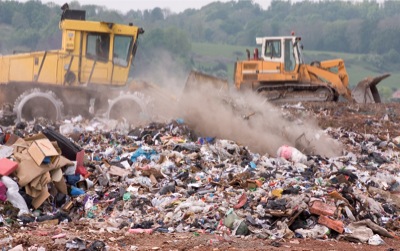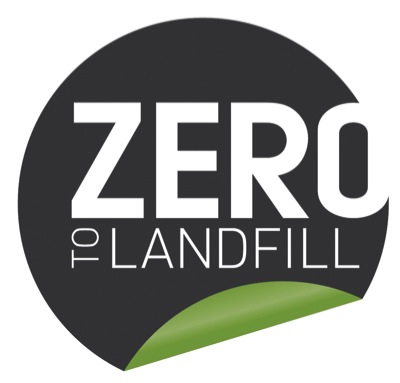Prismm Environmental and BPIF labels are working closely together on the Zero-to-Landfill project
It is estimated that in excess of 180,000 tonnes of waste from label printers is landfilled in the UK each year. The sector has an opportunity to take an industry wide lead in showing how environmental awareness can be made a priority, says Jon Hutton, sales director at Prismm Environmental Limited.
Plastic-based waste produced by label printers includes matrix, makeready, set up, off spec, etc, and although printing presses are becoming more and more efficient producing less waste, there are still vast amounts going into landfill in the UK each year. Relatively little is recycled, because typically there are various substrates fixed together on each reel – plastics with different chemical compositions – papers, adhesives and inks. Separating substrates from each other, such as plastics from non-plastics, in the recycling process is either labour intensive or not possible, and so far there has been no practical solution.
Only ‘pure plastics’, such as polypropylene, which have a value as a waste are recovered through the recycling process.
Challenges
Historically, the vast majority of reel/matrix waste has been disposed into landfill, with the leading criteria for this being that it is the most cost effective solution, an easy option, no knowledge of an alternative, and it is legal. A typical label printer will produce between 85% and 90% of landfill derived waste from their matrix label waste, and in an industry that continues to be hit hard with the recent downturn in economic times, the key driver will typically always be focused on disposal costs.
Singling out the above ‘no knowledge of an alternative’ reason; these wastes can actually be collected, processed and blended with other waste materials to produce an SRF (Solid Recovery Fuel) or RDF (Rubbish Derived Fuel). Waste that will be used as fuels by incinerators, however, need to be received in specific particulate forms so must be pretreated to create blends suitable for the incineration process. This pretreatment process involves shredding, granulating and blending various wastes together so it meets the incinerators specific criteria,such as granulate size, dryness, state and chlorine levels.
Even though waste-to-energy is a treatment option, however, label printers can not be held to ransom over the blame for continued mass landfill of their reel waste. Treating these materials via this recovery route is still largely not possiblethroughout the UK, and what solutions there are, are not made knowingly available to the print industry.
Regarding reel waste being unrecoverable, the problem is not so much the materials, but rather the form in which it is presented to the waste treatment sites. Very few treatment facilities have the capacity to deal with label waste that is still on its core. Matrix/reel waste on cores is simply too difficult for their equipment to shred into the particulate required for the incinerator, and those that have such equipment do not focus their attention at servicing the label printers as this is not a primary mass feedstock for their business model.
The treatment cost of material being recovered as RDF/SRF is slightly lower than that of landfill – both having a gate fee being charged by the tonne. However, the number of treatment outlets available in the UK are few and far between, which leads to the age old issue of transport costs usually outweighing any benefits of reduced treatment/selling costs. It is only with the annual increase to the landfill tax will the balance tip more favourably to recovery.
There are a number of label printers in the UK that are benefitting from SRF/RDF facilities and have been cost effective zero-to-landfill for some time. However, these are usually either situated within a local radius of the treatment site so costs are beneficial, or they are required to have the waste treated this way due to their customer requirements.
 In the UK, label printers generate some 180,000 tonnes of waste each year
In the UK, label printers generate some 180,000 tonnes of waste each year
Prismm and BPIF labels take up the challenge
The key to reducing label waste from landfill has three primary key drivers, (a) educating the industry, (b) creating a cost effective solution, and (c) engaging the supply chain to change the mind set that ‘change is usually only worthwhile when you’re saving money’. Taking wastes out of landfill as a ‘cost neutral’ practice and embracing the industries and individual printer’s environmental responsibility must be a reason to engage in change.
Educating the industry is the starting point. Prismm Environmental and BPIF labels have taken up the challenge and by working together have launched the ‘Zero-to-Landfill’ project specifically aimed at diverting matrix and reel wastes from landfill. However, beating the environmental responsibility drum requires credibility if the industry is going to listen with any real intent.
So, by engaging all the major film/adhesive label suppliers to the industry, including Avery Dennison, Herma, Ritrama, Tenza, UPM Raflatac and Mactac, it has gained unanimous agreement that the supply chain also has a responsibility to proactively sponsor and champion the project.
To date, these suppliers agree that change is required and it is hoped that in the future this attitude can be taken this to the next stage of educating their ‘customer facing’ personnel into the recycling options available when their products reach end of life. This knowledge can then become a pro-active part of the selling process and eventually lead to a culture change that is relayed down to their customers, the printer.
Initially, zero-to-landfill has embarked on a pilot scheme that has been launched in West and South Yorkshire, geography chosen due to the high density of label printers in these areas, whilst focusing on larger waste producers. The project has secured the commitment of a reputable local transport haulier that has a fleet of flat-bed artic trailers operating nationally, and a treatment facility that recovers and pre-treats all forms of label wastes, ready to be used as an solid recovered fuel.
By operating a service that does not see the movement of the material as waste but rather as a product, and securing commitment of the whole supply chain, it is possible to operate a cost effective service that achieves zero-to-landfill.
Under the new scheme, printers are supplied with steel cages for matrix/reel waste to be used for segregated storage from other wastes, mixed paper and plastic based substrates being stored together, which are then collected and replaced when full.
By using this service model, it can be demonstrated how printers now have the opportunity to divert 85% to 90% of their landfill waste to recovery as energy in one hit. With the pilot project in its third month, it has already ensured that in excess of 1,000 tonnes of label waste will no longer be landfilled each year.
 Most of the label waste in the UK still ends up in landfill
Most of the label waste in the UK still ends up in landfill
Shredding on site
Prismm Environmental is also working on a project on behalf of Pomeroy Pressroom Products, which offers another angle to help eliminate label waste from landfill. Pomeroy is the sole UK distributor of a system that shreds matrix waste as it comes off the press. Prismm has been commissioned to offer bespoke solutionsto the individual print sites, depending on geography, ensuring the waste benefits to this system can be realised and implemented immediately.
By shredding and removing the cores, the waste no longer needs to be diverted to a facility that has the shredding equipment required.
This opens up dozens of RDF facilities throughout the UK that can accept this material, which will ultimately be treated as waste-to-energy.
The waste can be collected automatically directly from the presses through a number of applications depending on printer requirements.
From sacks situated alongside each press to 35 yard compactor skips located outside the factory, ensuring all areas of waste management are immediately improved.
Systems range from simple standalone units to ones that integrate an entire multi press facility through associated ducting and compactor units being included. It reduces press downtime between runs, increases press running time, improves health and safety by eliminating matrix waste manual handling and ensures zero-to-landfill by removing the cores.
The road to recovery
As was perceived from the outset, the challenge is always going to be changing the majority of attitudes from focusing on the commercial aspect to the environmental impact of current practices. Medium to large print facilities can see instant financial benefits of label waste recovery due to the relatively high volumes of material being collected, along with benefiting from practically achieving zero-tolandfill overnight.
The lack of waste treatment facilities across the UK that can receive and process reel waste into fuels continues to hamper viable cost effective options for printers to utilise. Until sectors of the waste industry that can deal with this material recognise and act on the problems that prevent recovery, label waste producers will, without the finger of blame being pointed, continue to use the cheapest option available. Annual price increases to landfill tax should ensure that the balance of costs tip in the favour of recovery, however, although the cost for wastes being treated as RDF or SRF is slightly lower than landfill; any rise in landfill charges are typically mirrored.
Unfortunately, at a time when printers need to focus on costs in every aspect of their business, environmental responsibility understandably goes hand in hand with financial outcome. If this material was currently being treated as waste-to-energy and landfill prices began to fall, it is highly unlikely we would see waste diversion from landfill figures continue to improve.






